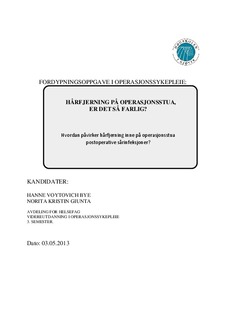| dc.contributor.author | Bye, Hanne Voytovich | |
| dc.contributor.author | Giunta, Norita Kristin | |
| dc.date.accessioned | 2013-06-11T11:32:46Z | |
| dc.date.available | 2013-06-11T11:32:46Z | |
| dc.date.issued | 2013 | |
| dc.identifier.uri | http://hdl.handle.net/11250/144547 | |
| dc.description.abstract | NORSK: Bakgrunn: Årlig rammes 3- 16 % pasienter innlagt ved norske sykehus av postoperative sårinfeksjoner. En nasjonal pasientsikkerhetskampanje, som går i perioden 2011- 2013, har blant annet fokus på postoperative sårinfeksjoner, og herunder om hårfjerning blir korrekt utført.
Hensikt: Med dette studiet, ønsker vi å sette fokus på hårfjerning inne på operasjonsstua, og hvilke konsekvenser dette kan ha for postoperative sårinfeksjoner. Med spesielt fokus på kontaminasjon av lufta på operasjonsstua.
Metode: Vi har benyttet litteraturstudie som metode i denne fordypningsoppgaven. Litteratursøkene ble gjort i anerkjente databaser som PubMed, Cinahl, Ovid Nursing, Embase og Medline, samt Google Scholar. Artikler vi har benyttet, har hovedsakelig handlet om preoperativ hårfjerning samt preoperative forberedelser, ventilasjon inne på operasjonsstua og postoperative sårinfeksjoner.
Resultat: Hovedfunnene i artiklene våres, gikk ut på antall personer på operasjonsstua, bevegelse inne på stua og at store partikler er en risiko for kontaminasjon av lufta på operasjonsstua. Hvite stafylokokker var den bakterien som oftest ble identifisert. Gule stafylokokker var også representert.
Konklusjon: Økt kontaminasjon av lufta, kan trolig forekomme ved hårfjerning på operasjonsstua. Det er usikkert om det har en direkte påvirkning på postoperative sårinfeksjoner. | no_NO |
| dc.description.abstract | ENGLISH: Background: Annual 3-16% patients admitted to Norwegian hospitals is affected of SSIs (Surgical site infection). A national patient safety campaign, which runs for the period 2011 - 2013, is among other things focusing on postoperative wound infections, and if the hair removal is done correctly.
Purpose: With this study, we want to focus on hair removal in the operating room, and the consequences this may have for SSIs. With particular focus on the contamination of the air in the operating theater.
Method: We have used literature based on sience as a method in this specialization thesis. The literature searches were made in recognized databases such as PubMed, Cinahl, Ovid Nursing, Embase and Medline and Google Scholar. Articles we have used are mainly focused on preoperative hair removal and preoperative preparation, ventilation in the operating room and surgical site infections.
Result: The main findings of our articles, was based on the number of persons in the operating theater, movement inside the operating room and that the large particles is a risk of contamination of the air in the operating theater. White staphylococci were the most commonly bacteria that were identified. Staphylococcus Aureus was also represented.
Conclusion: Increased contamination of the air may probably occur during hair removal in the operating room. It is uncertain whether it has a direct impact on surgical site infections. | no_NO |
| dc.language.iso | nob | no_NO |
| dc.subject | postoperative sårinfeksjoner | no_NO |
| dc.subject | hårfjerning | no_NO |
| dc.subject | operasjonssykepleie | no_NO |
| dc.subject | operasjonsstua | no_NO |
| dc.title | Hårfjerning på operasjonsstua, er det så farlig?: hvordan påvirker hårfjerning på operasjonsstua postoperative sårinfeksjoner? | no_NO |
| dc.title.alternative | Hair removal in the operating room, does it matter?: how does hair removal in the operating room, affect postoperative wound infections? | no_NO |
| dc.type | Student paper, others | no_NO |
| dc.subject.nsi | VDP::Medical disciplines: 700::Clinical medical disciplines: 750::General surgery: 780 | no_NO |
| dc.subject.nsi | VDP::Medical disciplines: 700::Health sciences: 800::Nursing science: 808 | no_NO |
| dc.source.pagenumber | 51 | no_NO |
